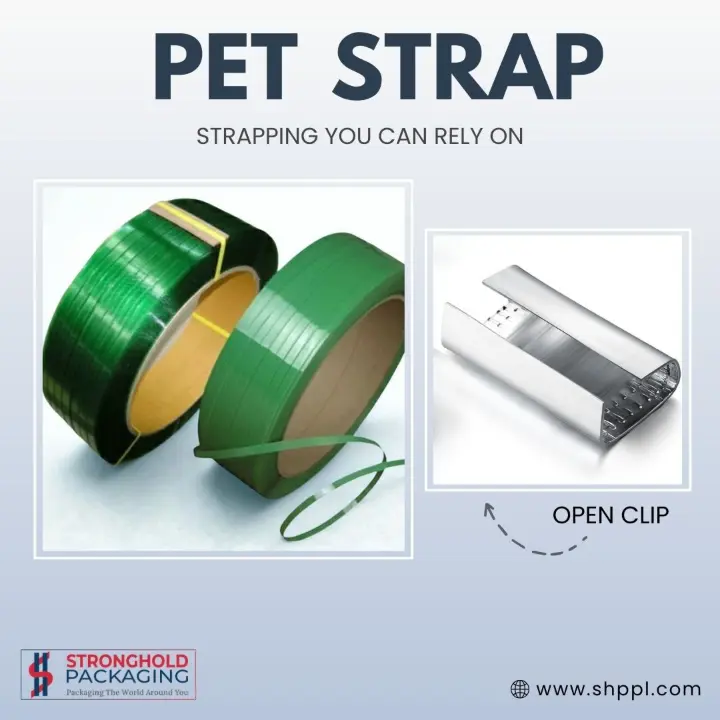
Packaging is quietly undergoing a structural shift. As freight costs, safety norms, and sustainability targets rise, how you secure a pallet has become a boardroom topic. Across Gujarat’s ceramics belt, engineering clusters, and FMCG hubs, we’re seeing rapid movement away from steel banding and thin polypropylene strap toward PET strap & clip systems that combine high strength, safe handling, and export credibility.
This article maps the five industry trends reshaping unitization—then shows how a modern PET strap & clip setup from Stronghold Packaging aligns with them, without overcomplicating your floor.
1) From Steel to Polyester: Strength With Memory (and Fewer Injuries)
Steel has linear strength, but it cuts hands, rusts, and can damage edges. PET (polyester) strap provides high system strength with elongation recovery (typically ~8–13%), absorbing shocks during rail and sea moves. Paired with a phosphated steel clip/buckle, the joint locks by friction and can be re-tensioned if loads settle—something steel seals simply can’t do.
What changes for your plant: fewer injury incidents, no rust stains, and a more forgiving strap that maintains tension across dwell times and temperature swings.
2) Automation Everywhere: Semi-Auto & Auto Machines Need Predictable Strap
Turntables, rotary arms, and semi-auto handheld tensioners demand repeatable strap geometry and surface. PET strap’s embossed texture improves grip in the clip and across corners; coils feed cleanly with lower dust than many PP options. Machine uptime rises; re-wraps drop.
Spec alignment: PET strap is available in 9–19–25–32 mm widths, 0.6–1.3 mm thickness, with break strengths from ~300 kg up to 800+ kg (grade-dependent). Works with manual ratchet tools, battery tensioners, and fully automatic strappers.
3) Export Buyers Want Evidence: Documented Loads, Traceable Lots
Audit culture is here to stay. Buyers now ask for batch traceability, RoHS/REACH-friendly statements, and in some lanes load-stability validations to EUMOS/ISTA styles. PET strap’s stability and clip re-tensionability support these outcomes—and suppliers like Stronghold provide batch labels on cores & cartons and test data on request so documentation doesn’t slow your container.
4) Sustainability Counts: Recyclability & Lower Injury Footprint
PET strap is 100% recyclable, does not rust, and reduces injury-related downtime versus steel banding. For plants reporting on EPR/ESG, downgrading steel usage and improving worker safety are quick wins. Green colorways also allow visual ID of securement zones without added labels.
5) Cost Focus Shifts to “Cost per Secured Pallet”
Tape and strap buyers are moving from “price per coil” to “cost per secured pallet”. PET strap’s tension retention and re-tensioning mean fewer failures and re-wraps. With the right grade and clip, most operations see claim reductions and faster bay cycles, especially through monsoon seasons when humidity punishes PP.
PET Strap & Clip: The System Specs That Matter (Explained Simply)
Widths: 9, 12, 16, 19, 25, 32 mm
Thickness: 0.6–1.3 mm (grade-linked)
Linear Breaking Strength (strap): ~1,400–2,500 daN in higher grades
System Strength (with matched clip): ~300–2,000+ kg depending on width/grade
Elongation: ~8–13% for shock absorption & tension retention
Surface: Embossed for grip; smooth options for special lines
Jointing: Phosphated steel clip/buckle (best grip), or heat-seal on compatible machines
Weather Window: Performs from -10°C to +60°C; UV-stable grades available
Colors: Standard green; custom on request
Compatibility: Manual ratchet, battery tools, semi-auto/auto strapping machines
Sustainability: 100% recyclable PET; optional recycled content grades
Why the clip matters: Stronghold pairs each strap width with a matching phosphated clip whose tooth geometry bites the PET fibers, enabling full system strength and safe re-tensioning. Mismatched clip sizes are the #1 cause of “mysterious” slippage.
Gujarat Snapshot: What Your Peers Are Standardizing
Ceramics & stone exporters (Morbi): 19 mm PET + 19 mm phosphated clip for pallets up to ~1 tonne; 25/32 mm for heavy crates.
FMCG & beverages: 12/16 mm PET for mixed B-loads; faster docks due to safe handling and no rust on shrink films.
Metals & timber yards: 25/32 mm composite PET with heavy-gauge clips for rough edges; edge protectors added on sharp profiles.
3PLs: Battery tools + 16/19 mm PET, standard SOP for mid-route re-tension.
Buyer Story: “From Rust Complaints to Clean Audits”
“We switched from 19 mm steel to 19 mm PET strap with phosphated clips for ceramic pallets. Injury incidents went to zero, and the re-tension step after staging stopped tilt failures. Our EU buyer highlighted the clean presentation—no rust, no edge scuffs—and we closed two quarters without a container claim.”
— Karan Patel, Export Head, TileWorks Gujarat
Implementation Playbook: Two Weeks to a Safer, Stronger Strap SOP
Map loads & routes — weight, corners, road/rail/sea mix, climate.
Select width by system strength — 16 mm for light/medium; 19 mm for mixed FMCG/ceramics; 25/32 mm for heavy machinery/stone.
Match clips — phosphated finish, same width as strap; verify tooth profile for your strap weave.
Tooling — ratchet or battery tensioner + quality cutters; dispensers to prevent tangles.
Trial & measure — tension retention after 24–48 hours; re-tension SOP for long dwell.
Document — batch numbers on cores, receiving checks, training sign-offs.
Scale — standardize 2–3 SKUs across sites; review claims monthly.
Why Stronghold Packaging for PET Strap & Clip?
System approach: strap + matched clips + tools + training—tested as a set.
Grade depth: woven & composite PET across 9–32 mm with precise break-strength windows.
Documentation on request: batch traceability, RoHS/REACH-friendly statements, and third-party tests where your buyer requires them.
Gujarat-first service: ready stock, demo tools, and operator SOPs to lock in results fast.
The market trend is clear: safer, cleaner, stronger unitization that audits love and teams trust. PET strap & clip is no longer an alternative; it’s the new baseline.ere...
